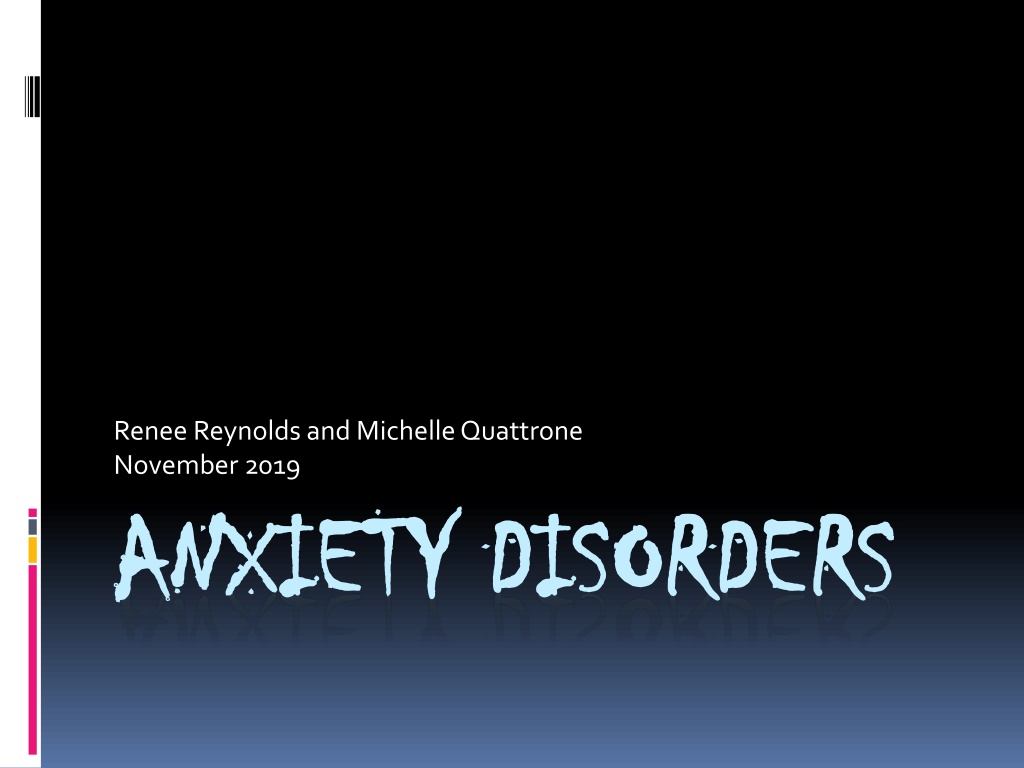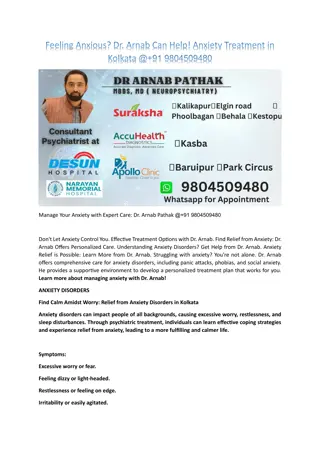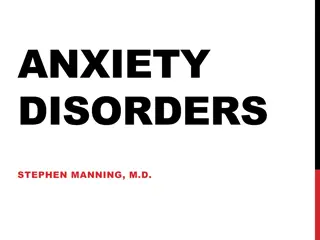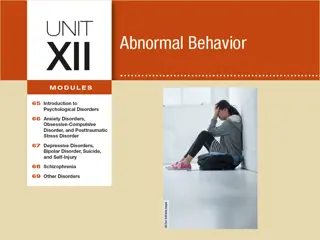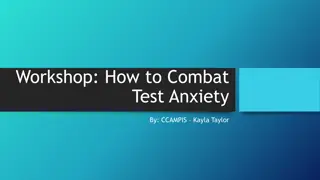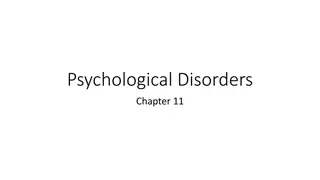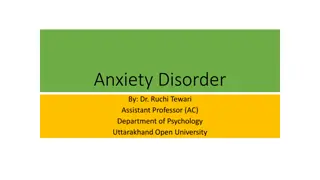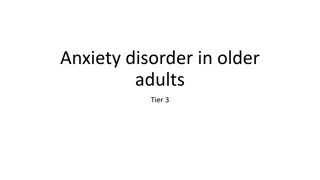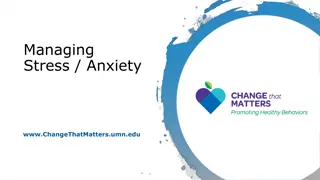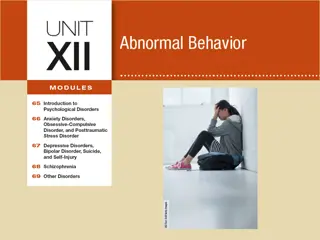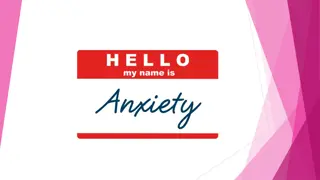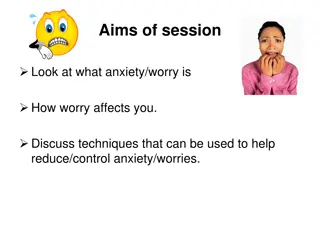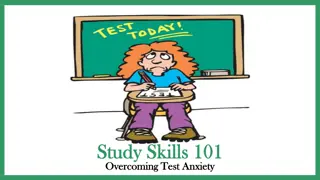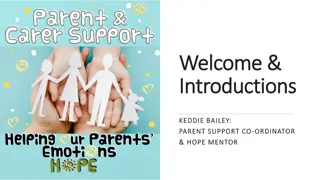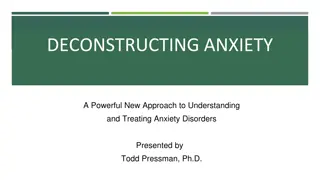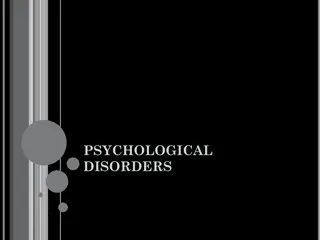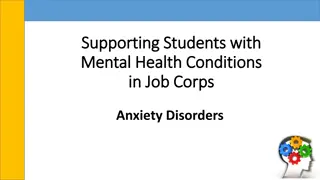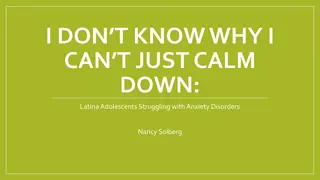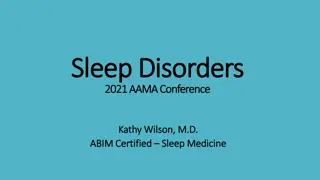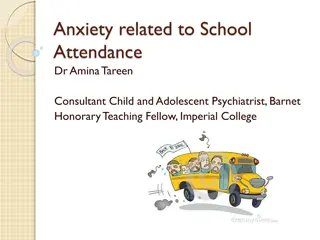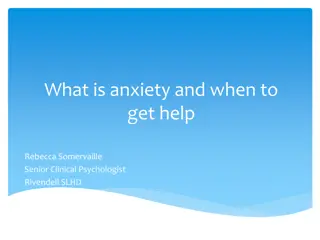ANXIETY DISORDERS
Anxiety is a common human emotion, but when it becomes overwhelming and interferes with daily life, it may indicate an anxiety disorder. These disorders can stem from various factors and manifest in different forms such as Generalized Anxiety Disorder (GAD), Social Anxiety, Obsessive-Compulsive Disorder (OCD), and Panic Disorder. Recognizing the signs and symptoms of anxiety disorders is crucial for seeking appropriate treatment, which can include therapy and medication.
Download Presentation

Please find below an Image/Link to download the presentation.
The content on the website is provided AS IS for your information and personal use only. It may not be sold, licensed, or shared on other websites without obtaining consent from the author.If you encounter any issues during the download, it is possible that the publisher has removed the file from their server.
You are allowed to download the files provided on this website for personal or commercial use, subject to the condition that they are used lawfully. All files are the property of their respective owners.
The content on the website is provided AS IS for your information and personal use only. It may not be sold, licensed, or shared on other websites without obtaining consent from the author.
E N D
Presentation Transcript
Renee Reynolds and Michelle Quattrone November 2019 ANXIETY DISORDERS ANXIETY DISORDERS
Anxiety Disorders Anxiety is a normal human emotion that everyone experiences at times. Anxiety is the emotion that protects people in fight or flight situations. When anxiety is prolonged or occurs at other times, it is an anxiety disorder. Anxiety disorders are serious mental health issues. For people with anxiety disorders, worry and fear are constant and overwhelming. The anxiety is so severe that it interferes significantly with occupational and educational functioning, social activities and close relationships. Anxiety disorders may develop from a complex set of risk factors, including genetics, brain chemistry, personality, life events and learned behavior. There are often physical symptoms that occur along side anxiety disorders. Some symptoms may include, heart palpitations, sweating, faintness, stomachaches, difficulty sleeping and irritability. It is estimated that 40 million adult Americans suffer from anxiety disorders. 1 out 8 children are affected by anxiety disorders each year. Anxiety disorders are highly treatable with therapy and/or medication.
Generalized Anxiety Disorder (GAD) A general tendency to be worried or anxious about many areas of life (health, money, career, etc). The anxiety is exaggerated and anticipatory making a mountain out of a mole hill. Children with GAD may be described as worry warts. They worry about many general problems such as school, sports performance, health, burglaries and even their parents jobs. Children with GAD will repeatedly ask questions and seek reassurance.
Social Anxiety This disorder is characterized by extreme anxiety about being judged by others. People with this disorder feel they are being judged at all times. This fear makes them avoid social situations whenever possible. Children with social anxiety worry excessively in situations where they have to interact with other people or be the focus of attention. These children fear that other people will think badly of them in some way.
Obsessive-Compulsive Disorder (OCD) These individuals are plagued by persistent, recurring thoughts (obsessions) that reflect exaggerated anxiety or fear. The obsessions then cause the person to perform a ritual or routine (compulsions) as a way to relieve the anxiety caused by the obsession. Obsessions=unwanted repetitive thoughts. Compulsions=the behavior the person is compelled to perform to alleviate the anxiety. Children with OCD have thoughts and themes that play on in their mind over and over again. They may worry about dirt or germs or about keeping things neat and orderly. They may also fear harm or danger to a loved one or self. They feel a need for perfection. These children may, therefore, perform a ritual and/or routine as a way to alleviate anxiety.
Panic Disorder People with panic disorders suffer severe attacks of panic, which may make them feel as if they are having a heart attack , dying or going crazy. These people worry excessively about having an attack. A panic attack is a sudden rush of fear that comes with lots of physical symptoms (racing heart, dizziness, trembling, tingling, and breathlessness). People with panic disorder feel that they can t leave the house (this disorder can lead to agoraphobia). Panic disorder is not common in children. It is more likely found in adolescents and young adults. Agoraphobia can be connected with panic disorder. It is the fear of being in places where escape or help would be difficult in the event of a panic attack. If you suffer from agoraphobia, you would avoid public places (shopping malls) or confined spaces (airplanes).
Posttraumatic Distress Disorder (PTSD) PTSD develops after exposure to a traumatic event in which grave physical harm occurred or was threatened. A traumatic event may be a sexual or physical assault, witnessing a death, the unexpected death of a loved one, or a natural disaster. There are three main symptoms associated with PTSD: reliving of the traumatic event (such as flashbacks and nightmares); avoidance behaviors (such as avoiding places related to the trauma) and emotional numbing (detachment from others). PTSD in children is a reaction to a serious traumatic event in which the child was extremely afraid or injured. Children may keep remembering the event or have bad dreams about it. They may suddenly act or feel as if the event is happening again and become upset. They may show jumpiness, sleep difficulties and irritability.
Phobias A phobia is an unrealistic or exaggerated fear of a specific object, activity, or situation that in reality presents little to no danger. Common phobias include-fear of animals (snakes, spiders ), fear of flying and fear of heights. People suffering from a phobia may go to great lengths to avoid the things they fear.
Hoarding Disorder Is a persistent difficulty discarding or parting with possessions because of a perceived need to save the them. A person with Hoarding Disorder experiences severe distress at the thought of getting rid of items. Excessive accumulation of items, regardless of their value, occurs. They feel they need the items. The items are reminders of happier times. They feel safer being surrounded by the items. Hoarding Disorder often creates such cramped living conditions that homes may be filled to capacity. Cases may range from mild to severe. May be related to OCD.
PANDAS-Pediatric Autoimmune Neuropsychiatric Disorder Associated with Strep Infections The bacterial infection causes the immune system to produce antibodies those antibodies attack the Basal Ganglia which is the part of the brain that controls emotions and physical movements. A child is diagnosed with PANDAS when OCD or Tic Disorders appear following a Strep Infection or when the symptoms of OCD or Tic Disorder become worse following a strep infection. Symptoms happen quickly out-of-the-blue. There is a rapid onset. Children may become moody, irritable, experience anxiety attacks or show concerns about separating from parents or loved ones. Children may experience ADHD symptoms, sleep disturbance, night time bed wetting, day-time urinary frequency, fine/gross motor changes (e.g., changes in handwriting), and joint pains.
Skin Picking Disorder Picking at a scab or the skin around the nails frequently and so intense that it causes bleeding, sores, and scars. It is a repetitive action to relieve stress. People usually feel bad after engaging in skin picking. Related to OCD because of the compulsive urge to perform repetitive behaviors.
Trichotillomania-Hair Pulling Disorder Involves recurrent, irresistible urges to pull out hair from scalp, eye brows, eye lashes and other areas of your body despite trying to stop. Compulsive urge to pull out hair. Pull out hair to relieve stress (focused and automatic) It is an impulse control disorder(they know this can do damage but they cannot stop). Related to abnormalities in brain pathways that link areas involved in emotional regulation, movement, habit formation and impulse control.
Separation Anxiety This is an anxiety disorder specific to children. It is one of the most common problems in childhood. 1 in every 25 children experiences separation anxiety. It is the fear of being away from a main caregiver. Children with separation anxiety fear that something terrible will happen to parent or child while they are apart and that they will never see each other again. Majority of separation fears emerge without a specific triggering event. However, it can be triggered by a stressful life event (real or imagined) These life events could be- -parents divorce, illness, death, family violence, being bullied etc). The development of separation anxiety has a lot to do with genetics (anxiety runs in families), the child s personality and temperament (child may have always been sensitive or clingy). Symptoms of separation anxiety: -constant thoughts and intense fears about the safety of caregivers -refusal to go to school -frequent stomachaches and other physical complaints -panic and tantrums at times of separation from caregivers -trouble sleeping or nightmares Children with separation anxiety will try to avoid separating. Avoidance is the key to keeping the anxiety alive.
How to help children with separation anxiety in school: Be reassuring of their safety (just remember that lots of positive attention to anxious behavior reinforces the anxiety). Connect with a safe person at school (Refer to school social worker or psychologist). Gradually expose the child to the situation (take 1 step at a time). Provide social skills development so children can learn to cope. They need to learn that they will be okay they can do it. Increase child s assertiveness skills so they can learn to ask for what they need stick up for themselves. Teach these children relaxation/self soothing techniques. Teach these children to self talk. Boost their self esteem/confidence (have them identify strengths). Provide support to parents during this stressful time. School social worker may refer student for outside mental health counseling (outside of school, a parent may wish to have their child participate in Cognitive Behavioral Therapy, family therapy or try medication). *Separation Anxiety is usually temporary and part of normal development (children figuring out the world around them).
Books to Ease Separation Anxiety The Kissing Handby Audrey Penn Llama Llama MissesMama by Anna Dewdney I Love You All Day Long by Francesca Rusackas and Priscilla Burris Mommy Don t Go by Elizabeth Crary and Marina Megale A Little Spot of Anxiety by Diane Alber I Can handle It by Laurie Wright The Invisible String by Patrice Karst
Resources Helping Your Anxious Child, by Ronald Rapee, PH.D, Ann Wignall, D. Psych., Susan H. Spence, PH.D, Vanessa Cobhan, PH.D and Heidi Lyneham, PH.D Helping Your Child Overcome Separation Anxiety or School Refusal, by Andrew R. Eisen, PH.D and Linda B. Engler, PH.D Help For Worried Kids, by Cynthia G. Last, PH.D Treating Anxiety Disorders in the School Setting, by Jordana McLoone American Academy of Child and Adolescent Psychiatry website www.anxietydisordersinchildren.com www.childanxiety.net
Treatment Cognitive Behavioral Therapy (CBT)-what they think and do affects how they feel If they avoid the fear, it stays strong If they face the fear it gets weaker Play therapy-helps a child work through their fears Validate the child s feelings Be confident that the child will be ok Give child coping skill for the situation
Treatment Continued Teach child how to problem solve the situation Take small steps Adult models calmness Speak to your child s pedestrian, school social worker or school psychologist
